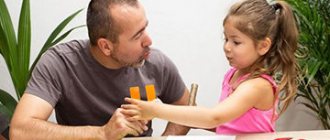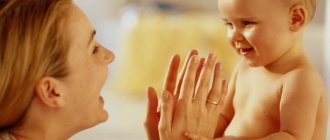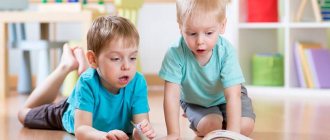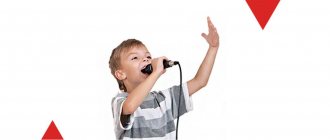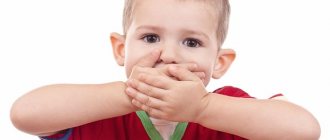Characteristics of the development of a 3-4 year old child
At 3 years old, the child is open to learning his native language, he happily repeats everything after an adult and is actively engaged in word formation. By the age of 4, the passive vocabulary reaches 2,500 words, most of which are verbs and nouns.
Three-year-old children have an extensive passive vocabulary
The child’s speech also contains:
- simple adjectives (beautiful, small, big);
- possessive pronouns (my);
- generalization words (animals, vegetables).
A preschooler does not yet have much life experience and produces new words in his own way. This gives rise to curious word forms, for example: “Mom is studying, but I am a lazybones.” A three-year-old child is able to maintain a simple dialogue.
The most difficult sounds to pronounce are “R” and “L”, as well as the whistling “Sh”, “S”, “F”. Often, even after reaching four years of age, the child is not able to pronounce them.
Important! If at 3-4 years old a child does not pronounce all sounds clearly, this is not a reason to run to a speech therapist. The sounds “R”, “L”, “Sh”, “S”, “F” are usually introduced at a later age. However, if by the age of 3 the baby does not speak at all, and there were serious illnesses or injuries during pregnancy/birth/in the first year, consultation with specialists is required. Based on the results of the examinations, a psychologist, speech therapist and neurologist will tell you what speech therapy exercises for children 3-4 years old should be performed.
When is it necessary to contact a speech therapist?
The age of a child of three years is optimal for the first visit to a speech therapist, since it is during this age period that the child is already ready to work with a specialist in a playful way, performing a certain set of exercises. You should contact us if you have the following features of speech development:
- the child does not speak at all;
- the child stutters, repeatedly repeating some words and prolonging the pronunciation of some sounds;
- tempo speech disorders - the baby speaks too quickly or, on the contrary, drawls out his words;
- incorrect pronunciation of sounds, “swallowing” and confusion of syllables;
- incorrectly selects prepositions and endings, resulting in speech that is illiterate and incomprehensible to others;
- lack of ability to logically construct phrases and sentences.
Possible causes of violations
Disturbances in the speech development of a preschooler may be associated with medical indicators or the child’s social environment.
Medical reasons:
- Mother's illnesses during pregnancy, smoking, alcoholism and drug addiction;
- Birth injuries and other complications;
- Head injury in the first 3 years of the baby;
- Left-handed child;
- The special structure of the articulatory apparatus;
- Heredity and genetic predisposition to speech disorders.
Social environmental factors:
- The baby hears little correctly delivered speech, adults are not interested in constant communication with him;
- Adults speak incorrectly (with mistakes, burr) or “lisp” with the child. As a result, by repeating, the baby remembers this manner of speech;
- An adult demands to pronounce the sound correctly, but at the same time does not show correct articulation. Often this leads to incorrect sound production, which subsequently has to be corrected (for example, “R” is pronounced with the throat).
Parents should talk to their children a lot
What is special about speech therapy classes with children of the corresponding age group?
Children of this age are actively getting acquainted with the world around them, and the task of adults is to create a rich developmental environment for the child. It is necessary to learn to follow the child, take into account his needs, interests and inclinations. Speech therapy lessons for 2-year-old children are based on imitation of an adult. Kids copy facial expressions, sounds and intonations. At the initial stage, the speech therapist takes on an active role, establishes emotional contact with the child and uses the child’s involuntary attention. A speech therapy lesson lasts 20-30 minutes, but changing types of activities and frequent repetition of verbal material is important. Speech therapy exercises for children 3 years old should be closely related to the child’s practical activities. It is important to praise the baby and encourage his activity, to study in a familiar environment. The child’s cognitive capabilities expand and it is recommended to actively use books and pictures.
Tests to determine pathologies
To quickly respond to changes in the baby’s development, you can conduct simple tests.
- By the fourth year, children can already distinguish the simplest geometric shapes. You need to ask the child to draw a circle. Even the similarity of this figure is a good result. However, if the child does not understand what is wanted from him, or his drawing does not even remotely resemble what is required, the test has not been passed.
- If a child does not show interest in new games and does not assemble a small tower from cubes, development is slow.
- By the age of three, the toddler communicates in short phrases (those who at this age already speak in long sentences are not taken into account). The minimum milestone for speech development by 3-4 years is the simplest phrases. If the child does not pronounce them, you should go to a specialist.
Formation of graphomotor skills in children with general speech underdevelopment
In what cases is it still necessary to contact a speech therapist:
- The baby does not respond to his name and does not understand simple requests.
- Shows no interest in new toys; all his game scenarios follow the pattern.
- He cannot assemble a simple turret or put a large bead on a rope.
- If by the age of three the child does not speak, there were injuries during pregnancy or early development, or there are hereditary diseases.
You should regularly conduct classes with children
Prices and duration of treatment
One lesson with a speech therapist or speech pathologist for a three-year-old child cannot last more than 45 minutes, since the baby is not yet ready to concentrate and maintain attention for a long time. The lesson usually takes place in the presence of parents, which allows you to create a comfortable atmosphere for the baby. The number of correctional classes is determined individually for each young patient, however, experts assure that if after 2-3 months of regular visits to a specialist, parents do not notice a noticeable improvement in the child’s speech skills, they should think about choosing another speech pathologist.
Consultation with a speech therapist - defectologist, initial appointment with detailed diagnostics (40 minutes - 1 hour) - 1800 rubles.
Repeated appointment, lesson (40 min - 1 hour) - 1500 rubles.
Speech therapy massage - 1500 rubles/session.
Probe massage - 1500 rubles/session.
What activities can be done with your child at home for speech development?
It's no secret that children spend most of their time at home.
Note! Therefore, it is so important to properly organize the baby’s activities aimed at developing children’s speech.
Articulation gymnastics and pronunciation training
Basically, all speech therapy classes for children 3-4 years old begin with small gymnastics for the organs of articulation. Most popular:
- Smile - stretch your lips in a smile, showing your teeth (the same without teeth).
- Dudochka - fold your lips into a tube and stretch them forward.
- Balloon - inflate your cheeks and hold the air for 3-5 seconds.
- Shoulder blade - place your tongue outstretched on the lower lip and fix it.
- Needle - tighten the tongue very much, make it as thin as possible and pull it forward, fix it.
- Jam - lick your upper and lower lips with your tongue.
- Let's brush our teeth - run your tongue over the upper teeth, then over the lower ones.
- Hill - the tongue rests on the lower teeth, while the middle of it tends to the palate, forming a hill. With this training, the child remembers the position of the tongue used to pronounce many sounds.
Games for hearing development
Children of primary preschool age are offered games to distinguish the volume of a sound or recognize an object that makes a sound. For many speech therapy tasks offered to children 3-4 years old, musical instruments such as pipes, drums, and piano are used.
Also at this age it is already possible to teach a child to distinguish sounds by ear. This can be done by offering a game: “Clap your hands when you hear the song of the water (sound “S”): sleep, frame, braid, mom, Sasha, etc.”
Games on sound culture of speech in secondary and preparatory groups
Important! It is best to call sounds by special “names”: the sound “S” is the song of the water, the sound “Sh” is the hiss of a snake, etc. It will be easier for the child to remember and orientate himself. When pronouncing a word in which the baby must highlight the sound, it should be exaggerated.
Finger gymnastics
This gymnastics is used as an activity for the development of speech for 4 years at home and in preschool educational institutions. By this age, the baby understands simple instructions and is able to follow them, and children's fine motor skills are already sufficiently developed to make small “compositions” from their fingers. Here are some of them:
- Lock - hands are tightly clasped in a lock, with the fingers of both hands intertwined with each other.
- Scratching - alternately depict “paws” with your right and left hands.
- Let's warm up our hands by rubbing our left palm vigorously with our right palm.
- Glasses - make a circle with the thumb and index finger of each hand and bring it to your eyes - put on glasses.
Finger gymnastics develops speech
Poetry learning, reading and storytelling
Children 3-4 years old often learn poetry, retell fairy tales, and learn to read during speech therapy sessions at home. This is facilitated by numerous manuals and workbooks for younger preschoolers, which can be purchased at any children's store or printed from the Internet.
The best authors of children's fiction: Korney Chukovsky, Alexander Pushkin, Agnia Barto, Samuil Marshak. The main task of memorizing short poems and retellings of works is to enrich the child’s vocabulary, expand his fantasy and imagination.
Note! In 2022, Bardysheva T.Yu. and Monosova E.N. published a special manual aimed at the comprehensive speech development of children of primary preschool age. The notebook by Monosova and Bardysheva consists of 120 pages of high-quality exercises and games that help increase the child’s active and passive vocabulary, develop phonemic awareness and coherent speech, and improve the processes of thinking, attention and memory. This manual was created both for professional speech therapists and defectologists, and for parents - it is written in simple and understandable language.
How are speech therapy classes organized for children 2-3 years old?
Speech therapy classes have a clear structure and include a number of mandatory elements: speech therapy gymnastics, training in proper breathing, developing diction with a speech therapist, developing speech expressiveness, working on intonation, stress, and tempo of speech. Before the start of the lesson, the speech therapist creates a favorable psychological atmosphere and unobtrusively prepares the child for speech therapy work. Speech therapy classes for children 2-3 years old involve the use of a rich arsenal of teaching methods. We use finger games, speech therapy simulation exercises, tasks to develop speech perception, vocabulary and other speech therapy work. The speech therapist uses pictures, educational toys, and various objects as material for lessons. Thanks to effective methods and original forms of delivery, speech therapy lessons for children 2-3 years old are effective.
What happens in our classes:
At the first lesson, the speech therapist diagnoses the current level of speech development of the child, the correspondence of speech status to the child’s age, and determines the nature of speech disorders. Based on the results of the initial examination, an individual plan for correctional work is drawn up, and the need for consultations with specialists in related specialties (psychologist, psychiatrist, neurologist, defectologist, neuropsychologist) is determined.
The speech therapy program, if indicated, includes regular play-based speech therapy sessions, logorhythmics, play and sand therapy as sensory, kinesthetic and speech stimulation.
The specialist will also determine the need for family-parent consultations, help analyze family relationships and see something very important, something that cannot be seen while inside the family system.
The active participation of parents in the implementation of the correctional work plan at home is undoubtedly the key to success!
Useful tips
Parents should be aware of the following points:
- Practice only when the child is in the mood to play. You should not force your son or daughter to take speech therapy classes.
- Show more patience, encourage your child, don’t scold him, don’t demand immediate correct pronunciation.
- Compose and invent new games according to the scheme of the previous ones, let your favorite children's characters and heroes of games and cartoons appear in your games.
- Do not despair if at first the child complains of fatigue. Gradually, his speech apparatus will become stronger, and correct reproduction will become the norm, a natural process.
Watch another game for speech development in the following video.

